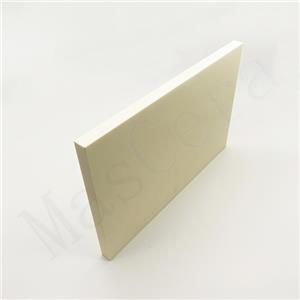Introduction to Advanced Ceramics Hot-press Molding Process
Hot-press molding is a widely used forming process in the production of advanced ceramics. Its basic principle involves the use of the characteristics of hot melting and cold solidification of paraffin wax. Ceramic powder is uniformly mixed with hot paraffin wax to form a flowable slurry, which is injected into metal molds under a certain pressure to shape it. After the wax slurry solidifies upon cooling, the molded body is removed from the mold. The molded body is then appropriately processed, embedded in an adsorbent, heated to remove the wax, and finally sintered into the end product.
The process of hot-press molding is as follows:
1. Add surface modifiers such as oleic acid and stearic acid to ceramic powder, ball mill them to make them hydrophobic and compatible with the wax.
2. Mix the modified powder with molten paraffin wax until it is uniform.
3. Inject the well-mixed slurry into a hot-press molding machine, molding it at the appropriate pressure and temperature.
4. Demold and make necessary adjustments to the molded body.
5. Embed the molded body in an adsorbent and heat it at a suitable rate to 900°C-1100°C to completely remove the wax and give the body some strength.
6. Place the molded body in a sintering furnace to produce the final product.
Advantages of hot-press molding:
1. It can shape complex ceramic products with high dimensional accuracy, requiring little to no post-processing. It is the primary forming process for producing shaped ceramics.
2. Short molding time and high production efficiency.
3. Compared to other ceramic forming processes, it has relatively low production costs and does not require highly specialized equipment or environments.
4. It is versatile and can be used with various materials such as oxides, non-oxides, composite materials, and various mineral raw materials.
Disadvantages of hot-press molding:
1. High porosity, relatively more internal defects, and low density, leading to poorer mechanical properties and stability of the products.
2. Requires a wax removal step, increasing energy consumption and production time. Thick-walled products are difficult to manufacture due to wax removal limitations.
3. Not suitable for producing large-sized ceramic products.
4. Difficult to produce high-purity ceramic products, limiting its application in high technological fields.
Applications of hot-press molding:
It is mainly used to produce small and medium-sized complex structural ceramics, wear-resistant ceramics, electronic ceramics, insulating ceramics, textile ceramics, heat-resistant ceramics, sealing ceramics, corrosion-resistant ceramics, and thermal shock-resistant ceramics.
XIAMEN MASCERA TECHNOLOGY CO., LTD. is a reputable and reliable supplier specializing in manufacturing and sales of technical ceramic parts. We provide custom production and high precision machining for a wide series of high performance ceramic materials including alumina ceramic, zirconia ceramic, silicon nitride, silicon carbide, boron nitride, aluminum nitride and machinable glass ceramic. Currently, our ceramic parts can be found in many industries like mechanical, chemical, medical, semiconductor, vehicle, electronic, metallurgy etc. Our mission is to provide the best quality ceramic parts for global users and it is a big pleasure to see our ceramic parts work efficiently in customers' specific applications. We can cooperate on both prototype and mass production, welcome to contact us if you have demands.




